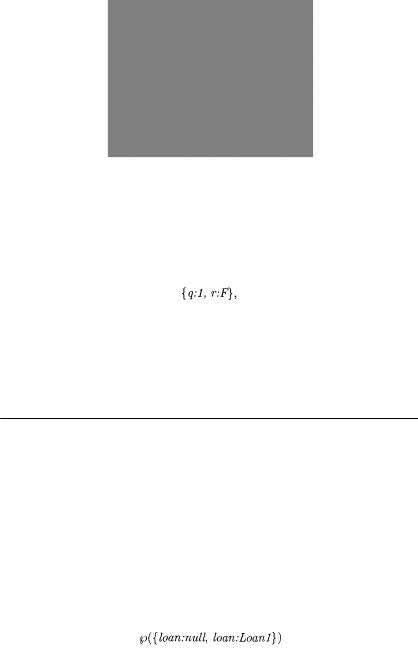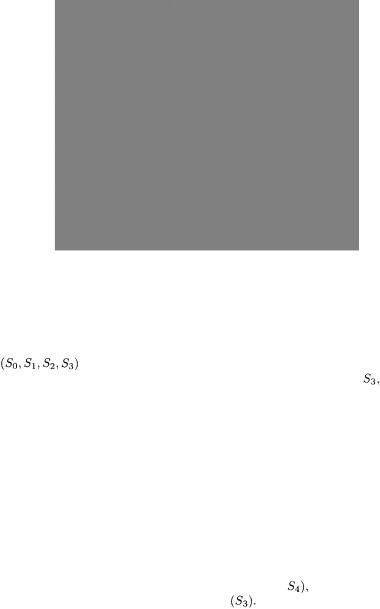
- •Contents
- •Introduction
- •1.1 Reverse Engineering
- •1.2 The eLib Program
- •1.3 Class Diagram
- •1.4 Object Diagram
- •1.5 Interaction Diagrams
- •1.6 State Diagrams
- •1.7 Organization of the Book
- •The Object Flow Graph
- •2.1 Abstract Language
- •2.1.1 Declarations
- •2.1.2 Statements
- •2.2 Object Flow Graph
- •2.3 Containers
- •2.4 Flow Propagation Algorithm
- •2.5 Object sensitivity
- •2.6 The eLib Program
- •2.7 Related Work
- •Class Diagram
- •3.1 Class Diagram Recovery
- •3.2 Declared vs. actual types
- •3.2.2 Visualization
- •3.3 Containers
- •3.4 The eLib Program
- •3.5 Related Work
- •3.5.1 Object identification in procedural code
- •Object Diagram
- •4.1 The Object Diagram
- •4.2 Object Diagram Recovery
- •4.3 Object Sensitivity
- •4.4 Dynamic Analysis
- •4.4.1 Discussion
- •4.5 The eLib Program
- •4.5.1 OFG Construction
- •4.5.2 Object Diagram Recovery
- •4.5.3 Discussion
- •4.5.4 Dynamic analysis
- •4.6 Related Work
- •Interaction Diagrams
- •5.1 Interaction Diagrams
- •5.2 Interaction Diagram Recovery
- •5.2.1 Incomplete Systems
- •5.2.2 Focusing
- •5.3 Dynamic Analysis
- •5.3.1 Discussion
- •5.4 The eLib Program
- •5.5 Related Work
- •State Diagrams
- •6.1 State Diagrams
- •6.2 Abstract Interpretation
- •6.3 State Diagram Recovery
- •6.4 The eLib Program
- •6.5 Related Work
- •Package Diagram
- •7.1 Package Diagram Recovery
- •7.2 Clustering
- •7.2.1 Feature Vectors
- •7.2.2 Modularity Optimization
- •7.3 Concept Analysis
- •7.4 The eLib Program
- •7.5 Related Work
- •Conclusions
- •8.1 Tool Architecture
- •8.1.1 Language Model
- •8.2 The eLib Program
- •8.2.1 Change Location
- •8.2.2 Impact of the Change
- •8.3 Perspectives
- •8.4 Related Work
- •8.4.1 Code Analysis at CERN
- •Index

122 6 State Diagrams
Fig. 6.2 shows three abstract interpretations of the method insertQuarter. The first two refer to the abstract domain (1) with 4 symbolic values for  while the last one refers to the smaller domain (2) with only 2 symbolic values for
while the last one refers to the smaller domain (2) with only 2 symbolic values for  Two different initial conditions are considered in the first two interpretations.
Two different initial conditions are considered in the first two interpretations.
In the first abstract interpretation, conditions in both if statements evaluate to false, since  is not among the propagated values. Correspondingly, the output of the two associated then branches is the empty set. In the second abstract interpretation, the first condition q == 2 evaluates to false, while the second evaluates to true, due to the incremented value assigned to
is not among the propagated values. Correspondingly, the output of the two associated then branches is the empty set. In the second abstract interpretation, the first condition q == 2 evaluates to false, while the second evaluates to true, due to the incremented value assigned to  Thus, only the else branch is taken in the first if, while the then branch is taken in the second if statement. As a result, in the second interpretation the final ab-
Thus, only the else branch is taken in the first if, while the then branch is taken in the second if statement. As a result, in the second interpretation the final ab-
stract value of is |
indicating that the coffee machine is ready to prepare |
|
a coffee. |
|
|
In the last abstract interpretation, the result of incrementing |
is |
|
Such a value does not allow deciding on the truth value of the condition in the second if statement. Correspondingly, both branches are taken, and the final
result |
contains both values |
and |
associated to variable |
The only |
||
“true” value is |
because when the starting value of |
is zero |
the |
|||
then branch of the |
if statement cannot be taken and |
cannot be assigned |
||||
to |
However, the low granularity of the abstract domain chosen does not al- |
|||||
low distinguishing |
from |
|
and correspondingly the actual execution |
|||
path cannot be obtained. It should be noticed however that the paths followed during abstract interpretation are a superset of the “true” paths (safe interpretation), and that the final results contain those that actually occur (conservative output).
The higher accuracy obtained using the first abstract domain, with respect to the second one, indicates the importance of choosing the right abstraction. Such a choice depends on the problem being solved by abstract interpretation. In some cases, the gross grain abstraction (2) may suffice. In the next section, application of abstract interpretation to the recovery of the state diagrams will be described and the problem of choosing the right abstraction will be reconsidered in such a context.
6.3 State Diagram Recovery
The first step in the recovery of a state diagram for a given class consists of defining an appropriate abstract domain for its attributes and (possibly) for the variables involved in attribute computations. Correspondingly, the abstract semantics of each operation in the class methods must be also provided.

6.3 State Diagram Recovery |
123 |
Then, abstract interpretation of the class methods gives the transitions from state to state to be represented in the state diagram. The algorithm for this final step is described in detail below.
In a state diagram, the effects of method invocation on the attribute values are abstracted by considering only “meaningful” equivalence classes of such values. The decision on which equivalence classes should be considered is a non trivial one, and deeply affects the characteristics of the resulting state diagram. Thus, the role of the programmer in this recovery process consists of establishing proper groupings of attribute values that correspond to the different states in which the class can be, and that give rise to different behaviors, in response to method invocations. Such a choice can by no means be automated. Usually, indicators of the boundary values that separate the equivalence classes are available from the constant values used in conditional expressions (if any). Since different execution paths are taken when values are below or above these boundaries, it is likely that these characterize meaningful equivalence classes of values. However, human intervention is unavoidable to determine the proper granularity of the abstraction. Moreover, it is often the case that accurate results can be obtained from abstract interpretation only if some groups of attributes/variables are described jointly, since they are mutually influenced by the values of the each other. If no joint description is adopted, the result of abstract interpretation is over-conservative and produces a state diagram where abstract values that can never occur in any execution are present in some states. A possible solution is an iterative state diagram recovery process, where the output of an initial guess on a possible abstract domain is refined if it appears that the resulting state diagram contains lots of non admissible attribute values.
Fig. 6.3. Algorithm for the recovery of the state diagram.

124 6 State Diagrams
Fig. 6.3 shows the pseudocode of the recovery algorithm. It assumes that an abstract domain for the class variables has already been properly defined.
First of all, the algorithm determines the initial states in which any object of the given class can be. This is obtained by executing an abstract interpretation of each class constructor starting from an initially empty state (see line 3). The state obtained at the exit of each constructor after abstract interpretation is one of the possible initial states for the objects of this class (line 4). Such a state is also a possible starting point for a further method invocation, so that it must be inserted into a set of pending states (pendStates) that will be considered later by abstract interpretation (line 5). Each available class method will be applied to them. Moreover, the state reached after constructor execution is one of the states to be included in the resulting state diagram. Correspondingly, it is inserted into the set of all the states in the diagram (allStates, line 6). All the edges in the state diagram that end at the initial states, recovered in this phase, depart from the entry state of the diagram, which is conventionally indicated as a small solid filled circle.
Then, the recovery algorithm repeatedly executes an abstract interpretation of the class methods as long as there are pending states to be considered (loop at line 8). Each pending state is removed from pendStates (line 9), and each class method is interpreted using the removed pending state as the initial state (line 11). When the final state obtained by the abstract interpretation has not yet been encountered, it is added both to the set of still pending states (line 13) and to the set of diagram states (line 14).
Recovery of the edges in the state diagram is not explicitly indicated in Fig. 6.3. However, the related rules are quite simple. As described above, the initial states (initStates) are the targets of edges outgoing from the entry state.
As regards the other states, |
when the abstract interpretation of method |
||
is conducted (line 11), the starting state used by the interpretation is |
and |
||
the final state it produces is |
Thus, an edge labeled |
is added in the state |
|
diagram from to |
|
|
|
coffee machine example
Let us consider the application of the algorithm in Fig. 6.3 to a hypothetical class CoffeeMachine, implementing the coffee machine example, using the first abstract domain (1) defined in Section 6.2. Let us assume that this class has only one constructor, which resets the behavior of the machine by assigning 0 to  and false to
and false to  Correspondingly, only one initial state is recovered by performing the abstract interpretation of the constructor starting from the empty set:
Correspondingly, only one initial state is recovered by performing the abstract interpretation of the constructor starting from the empty set:  (see Fig. 6.4, method CoffeeMachine).
(see Fig. 6.4, method CoffeeMachine).
The class CoffeeMachinemay define three methods, reset, insertQuarter and makeCoffee, which, following the steps in Fig. 6.3, are interpreted from the only pending state produced so far, the initial state  While reset and makeCoffee give a final state equal to the initial state (see Fig. 6.4), so that no other pending state is generated, method insertQuarter produces
While reset and makeCoffee give a final state equal to the initial state (see Fig. 6.4), so that no other pending state is generated, method insertQuarter produces

6.4 The eLib Program |
125 |
Fig. 6.4. Results of the abstract interpretation of the methods in the CoffeeMachine class under all possible initial states.
a final state never encountered so far,  This is added to the set of pending states and is examined in the next iteration of the algorithm. The detailed steps performed in the abstract interpretation of insertQuarter from the initial state
This is added to the set of pending states and is examined in the next iteration of the algorithm. The detailed steps performed in the abstract interpretation of insertQuarter from the initial state  have already been described (see Fig. 6.2).
have already been described (see Fig. 6.2).
Then, the next pending state, is considered. The abstract interpretation of makeCoffee produces a final state equal to the initial one, while reset gives a final state equal to the already encountered state  Interpretation of insertQuarter (see Fig. 6.2) generates a new state,
Interpretation of insertQuarter (see Fig. 6.2) generates a new state,  Interpretation of reset, insertQuarter and makeCoffee from such a state completes the execution of the state diagram recovery algorithm. A graphical display of the resulting diagram has been provided previously, in Fig. 6.1.
Interpretation of reset, insertQuarter and makeCoffee from such a state completes the execution of the state diagram recovery algorithm. A graphical display of the resulting diagram has been provided previously, in Fig. 6.1.
6.4 The eLib Program
Let us consider the class Document from the eLib program (see line 159 in Appendix A). Among its attributes, the one which mostly characterizes its state is loan. The set of all possible values that can be assigned to loan can be abstracted into loan:null, representing the case where loan references no object (the document is not borrowed), and loan:Loan 1, representing the case where loan references an object of type loan (the document is borrowed). The abstract domain to use in the construction of the state diagram for this class is thus:
where  indicates the powerset.
indicates the powerset.

126 6 State Diagrams
The class methods that may change the state (restricted to the attribute loan) of a Document object are: addLoan (defined at line 202) and removeLoan (defined at line 205). In order to perform their abstract interpretation, the specification of the abstract semantics is required for the two following assignment statements (taken from lines 203 and 206):
Statement |
Abstract |
semantics |
||
loan |
= |
ln |
{loan:*} |
{loan:Loan 1} |
loan |
= |
null |
{loan:*} |
{loan:null} |
The underlying hypothesis is that the method addLoan has a precondition, requiring that it is invoked only with a non null parameter. Such a check is not performed by the method itself, being considered the caller’s responsibility. Under this hypothesis, the first assignment, where the right hand side is the parameter ln of addLoan, does not need to include loan:null in the result set of its abstract semantics.
Here is the result of the abstract interpretation of the constructor Document (line 166), of the methods addLoan (line 202) and removeLoan (line 205) from all possible starting states:
Method |
Initial state |
Final state |
Document |
{} |
{loan:null} |
addLoan |
{loan:null} |
{loan:Loan1} |
|
{loan:Loan1} |
{loan:Loan1} |
|
|
|
removeLoan |
{loan:null} |
{loan:null} |
|
{loan:Loan1} |
{loan:null} |
|
|
|
We can assume that addLoan is called only if the Document is available (see check at line 59), i.e., from state {loan:null}, and that removeLoan is called only when the document is out (see check at line 68). This prunes two selftransitions from the state diagram: that from {loan:Loan1} to {loan:Loan1}, due to the call of addLoan, and that from {loan:null} to {loan:null}, due to removeLoan. The resulting state diagram is shown in Fig. 6.5.
As a second example, let us consider the class User (see line 281) and its attribute loans, which can be regarded as the one that defines the state of the objects belonging to this class. Since loans is of type Collection, its values can be abstracted by the number of elements it contains. We can distinguish the case of no element inserted (abstract value loans:empty), from the case of one element inserted (abstract value loans:one), from the case of more than one element inserted (abstract value loans:many).
The methods that possibly modify the content of the Collection loans are: addLoan (line 314) and removeLoan (line 320). Correspondingly, the abstract semantics of the following operations is required:

6.4 The eLib Program |
127 |
Fig. 6.5. State diagram for class Document.
Statement |
Abstract semantics |
loans.add(loan) |
{loans:empty} {loans:one} |
|
{loans: one} {loans:many} |
|
{loans:many} {loans:many} |
loans.remove(loan) |
{loans: empty} {loans:empty} |
|
{loans:one} {loans:empty, loans:one} |
|
{loans:many} {loans:one, loans:many} |
|
|
Removal of an element from a Collection containing just one element may give an empty collection, if the removed element is contained in the Collection, or an unchanged Collection, if the element is different from the contained one. Removal of an element from a Collection with more than one (many) elements may still give a Collection with more than one element, or may give aCollection with exactly one element, if it previously contained two elements, among which one is equal to that being removed.
Assuming that the precondition of the method removeLoan is the presence of its parameter loan in the Collection loans (this is ensured in its invocation inside class Library at line 53, as apparent from the body of method returnDocument, lines 66–75), the abstract semantics given above can be sim-
plified into: |
|
|
|
Statement |
|
Abstract semantics |
|
|
|||
loans.add(loan) |
|
{loans:empty} {loans:one} |
|
|
|
{loans:one} |
{loans:many} |
|
|
{loans:many} {loans:many} |
|
|
|
|
|
loans.remove(loan) |
|
{loans:empty} |
{loans: empty} |
|
|
{loans:one} {loans:empty} |
|
|
|
{loans:many} |
{loans:one, loans:many} |
|
|
|
|
The abstract interpretation of methods User (line 288), addLoan (line 314) and removeLoan (line 320) using the abstract semantics above, produces the

128 6 State Diagrams
state diagram depicted in Fig. 6.6. The transition from state {loans:many} to {loans:one, loans:many} due to the invocation of removeLoan is represented as a non deterministic choice between the target states {loans:one} and {loans:many}. Moreover, the precondition of removeLoandiscussed above ensures that it is never called when loans is empty. Thus, no self-transition labeled removeLoan is present in the state 
Fig. 6.6. State diagram for class User.
Let us consider the class Library (see line 3). Its three attributes documents, users, and loans define the state of its objects. It is possible to consider these three attributes separately, building a distinct state diagram for each of them. The result is a set of so-called projected state diagrams. The overall state of the class, described by the joint values of all its state variables, is projected onto a single state variable, by considering the values it can assume and ignoring the values assumed by the other variables.
Since the three attributes documents, users, and loans are containers of other objects, it is possible to abstract their values into the symbolic values empty and some, indicating respectively that no object is contained or that some (i.e., at least one) objects are contained. Abstract interpretation of the methods that modify these containers is similar to the abstract interpretation of the methods of class User described above, with the only difference being that the values of container loans from class User have been modeled by three abstract values (empty, one, and many), while for class Library no distinction is made between one and many, both of which are abstracted as some.
The three projected state diagrams resulting from the abstract interpretation of methods addDocument (line 24), removeDocument (line 31), addUser

6.4 The eLib Program |
129 |
(line 8), removeUser (line 15), addLoan (line 40), removeLoan (line 48) are depicted in Fig. 6.7. The removal methods removeDocument and removeUser have no effect if applied in the state  (empty) of the diagrams for the attributes documents and users. On the contrary, the removal method removeLoan can never be invoked in the state
(empty) of the diagrams for the attributes documents and users. On the contrary, the removal method removeLoan can never be invoked in the state  of the diagram for loans, because of the check performed by the calling method returnDocument (see line 68, where isOut returns true only if the document references a non null Loan object, stored inside the attribute loans of class Library).
of the diagram for loans, because of the check performed by the calling method returnDocument (see line 68, where isOut returns true only if the document references a non null Loan object, stored inside the attribute loans of class Library).
Fig. 6.7. Projected state diagrams for class Library.
If the attributes of a class vary independently from each other, the combined state diagram can be obtained as the Cartesian product of the projected state diagrams, with a number of states that grows as the product of the number of states in the separate diagrams. Transitions are obtained by all combinations of transitions in the substates.
If we consider the combined state diagram for class Library, the total |
|
number of states it contains is not 8 (2 × 2 × 2), as it would occur in case |
|
of independent projections. The combined state diagram, shown in Fig. 6.8, |
|
contains 5 states, because some combinations in the Cartesian |
product are |
prohibited by preconditions that are checked before calling some |
of the meth- |
ods in this class.
Let us represent the three abstract values that have been defined for the three state attributes (document, users, loans) of this class as a triple,
with the symbolic values |
indicating the abstract value empty and indi- |
cating some. The triple |
is thus the abstract value for a combined |
state of class Library, with the following joint values of the state variables: documents=empty, users=some, loans=empty.
Fig. 6.8 shows the combined state diagram, as obtained by applying some constraints (explained below) on the invocation of the involved methods. As regards the first two variables represented in the triples that characterize the

130 6 State Diagrams
Fig. 6.8. Combined state diagram for class Library.
states, it is evident that they vary independently from each other. In fact, all possible combinations of the values of these variables are in the diagram, and every method invocation remains possible in each state. Correspondingly, the upper part of the diagram in Fig. 6.8 contains exactly 4 (i.e., 2 × 2) states
and 20 related transitions. |
|
The invocation of method addLoan can only be made in state |
where |
documents=some and users=some, i.e., only in the presence of registered users and documents in the library. In fact, the method borrowDocument checks (see line 57) that both of its parameters (user of type User and doc of type Document) are not null. Since such parameters are obtained from class Library, which in turn exploits its attributes users and documents to retrieve them, the execution of borrowDocument proceeds until the invocation of addLoan only if at least one user (referenced by parameter user) and one document (referenced by doc) are in the library. The result of calling addLoan in  is a transition to
is a transition to  where all state variables are equal to some, i.e., there are registered users and documents, and there are active loans.
where all state variables are equal to some, i.e., there are registered users and documents, and there are active loans.
Since method removeLoan is never called with loans empty, as discussed above, the only state that has outgoing transitions labeled by removeLoan is  where loans=some. The deletion of a loan can either lead to a state in
where loans=some. The deletion of a loan can either lead to a state in
which some loans are still active (self transition in |
or it can lead to a |
|
state where no loan is active in the library |
This is the reason for the non |
|
deterministic transition triggered by removeLoan, with two possible target states.
In state  removal of documents (method removeDocument) or users (method removeUser) can never result in a state of the library with an empty
removal of documents (method removeDocument) or users (method removeUser) can never result in a state of the library with an empty
